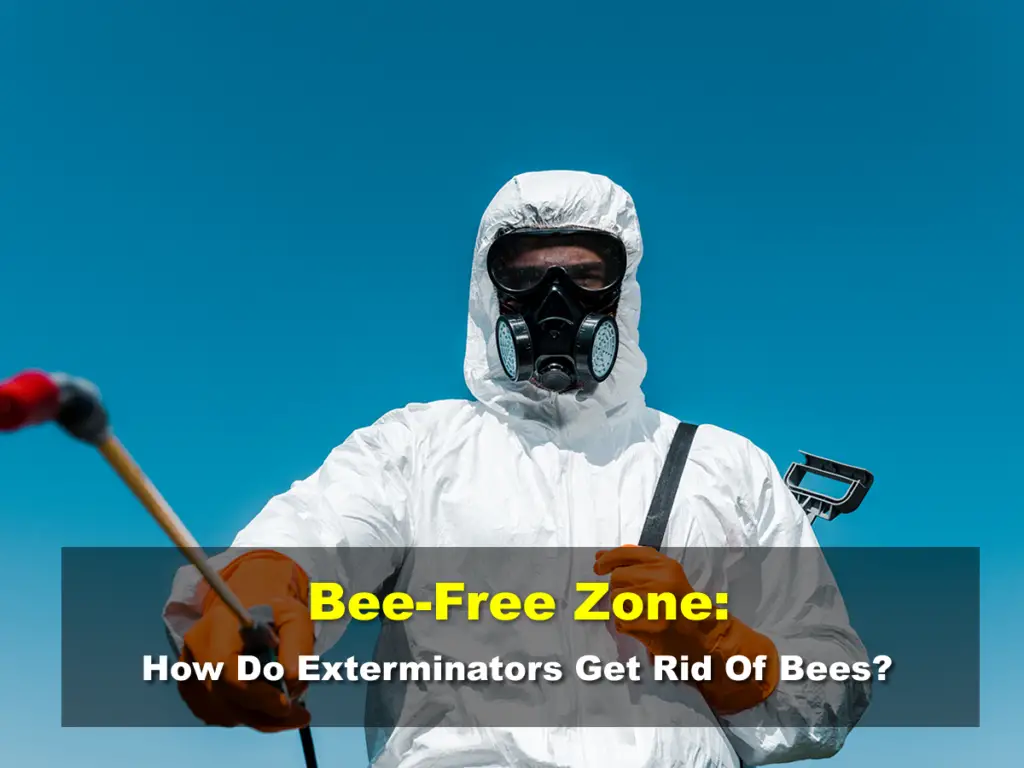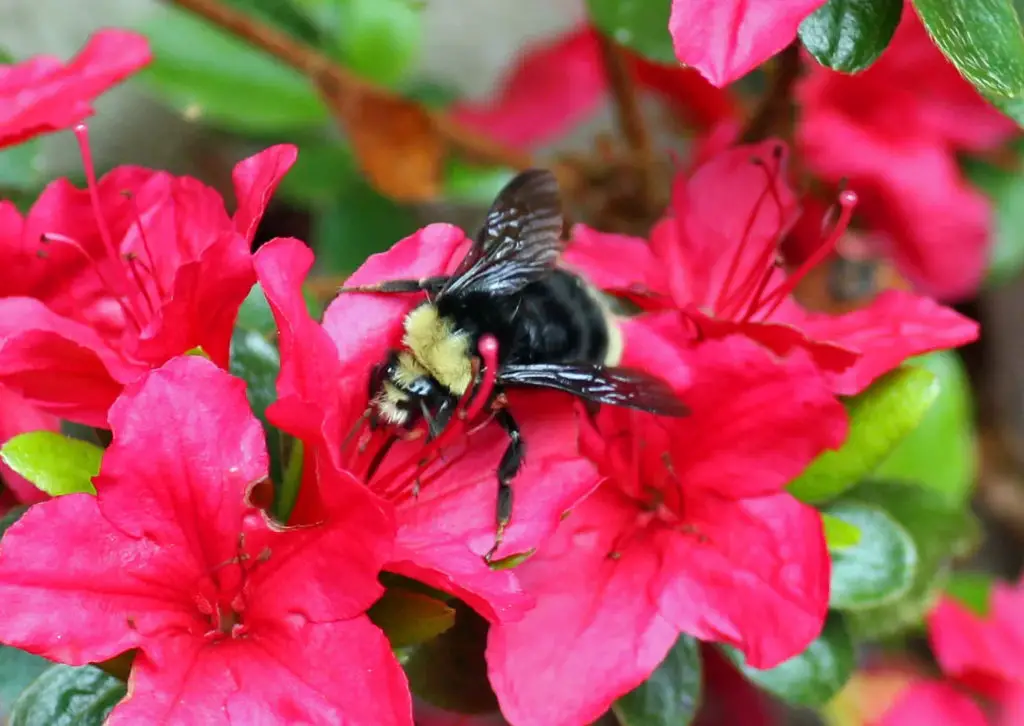Affiliate Disclaimer - As an Amazon Associate I earn from qualifying purchases.
It supports the website. So, Thank you
If you’re having problems with bees in or around your home then you’ll obviously want to get rid of them. Many people are keen to take a natural approach, understanding the importance of not harming bees. However, hiring a pest control expert is one of the most efficient methods for removal but how do exterminators get rid of bees?
For the most part, exterminators will use a spray or dusting powder directly in the nest, effectively killing the bees. That said, there are some pest control experts that offer bee nest removal and relocation services. Which method they use will depend on the circumstances.
The approach you take will often depend on the severity of the bee infestation and what methods you have already tried. In this guide, I’ll explain a little more about what to expect from an exterminator and some other potential approaches you might choose.
Table of Contents
Do Exterminators Kill Bees?
Bees are an incredibly important part of the natural world. They’re pollinators and are responsible for the pollination of up to 75% of human crops and wildflowers. Without them, the world would be a very different place.
Of course, having them in and around your property isn’t always welcome. While one or two bees might not pose much of a problem, an entire nest can be very destructive.
So, in order to remove the bees, a lot of people turn to a pest control service or exterminator. Now, the very word exterminator would suggest that these professionals’ main aim is to kill the bees. But this isn’t always the case.
They’ll first perform an assessment and decide on the best course of action. Where an infestation is considered dangerous or an emergency, most pest controllers will suggest using an insecticide treatment to kill off the colony.
Identifying The Bee Species
When you contact your local exterminator, the first thing they’ll do is take a look at the problem to figure out how severe or harmful it may be.
There are around 20,000 different species of bees and around 4000 of these can be found in North America. Some of the most common bee species here include the European honey bee, the carpenter bee, the sweat bee, and the bumble bee.
Most bee species are very docile and don’t pose a threat to humans in terms of stinging. In fact, they typically only sting when they feel threatened. The problem is that, when you have a nest in your garden, the bees may be more aggressive as one of their main aims in life is to protect their nest.
While you may not have any intention of harming them, the bees don’t know this and even just being in the proximity of the nest could cause them to become alarmed. Not only this but some bee species, like the carpenter bee, can cause damage to wooden structures by drilling into them to create nests.
With this in mind, your exterminator will assess the situation and make a decision on whether the bees pose a serious threat or whether they can be removed humanely.
Making The Right Call
As I have discussed above, your exterminator will make a decision based on various factors related to the infestation.
However, it’s really important to keep in mind that every situation is different. Most exterminators will be keen to handle the situation as humanely as possible because they’re aware of the importance of bees.
In some cases, and usually, as a first port of call, pest control experts will attempt to remove the bee’s nest or trap the bees to be released elsewhere. They may also make efforts to remove and relocate the nest, where possible, or make it more difficult for bees to continue nesting. For example, where there is a carpenter bee problem, they may layer materials over wooden structures so that the bees cannot drill through.
But this isn’t always the most effective method and where an infestation could be dangerous, they’ll turn to more severe measures.
It’s important to keep in mind that while I would never advocate the mass killing of bees, where humans may be at risk, there is usually no other alternative. For example, if the bees are entering your home, this could be risky and you have to put yourself first.
Where more extreme measures are needed, the exterminator will use an insecticide product such as a dusting powder or a spray that is designed to kill the bees. Once they are dead, the nest can then be sealed or destroyed.
It is important, after this, that homeowners continue to take steps to bee-proof their property. I’ll discuss some natural ways to deter bees later in this guide. Alternatively, some pest control companies offer prevention services where they’ll attend your property on a quarterly or bi-annual basis.
Bee Removal Services From Beekeepers
There are thousands of beekeepers in the United States who are often keen to help residents with bee problems.
However, it’s worth keeping in mind that this service doesn’t always come for free. Some people will tell you that beekeepers always remove nests free of charge and while this is sometimes the case, it’s not always.
For example, a hobby beekeeper may be more than happy to remove a colony as they will then be able to take on the bees themselves. But I have read stories of hobbyists turning down removal if the colony is well established as they don’t like to disturb the bees.
On the other hand, there are many professional beekeepers who will happily remove any colony for a fee.
What’s available will depend on where you live so it’s worth speaking to local beekeepers and finding out what services they offer. It’s also worth mentioning that there are bee associations in every state that may be able to offer advice.
Natural Alternatives For Getting Rid Of Bees
Most people are aware that bees are an integral part of our ecosystem and are keen to remove them without causing any harm. While insecticide treatments may be an effective method, they should be left as a last resort.
Before contacting an exterminator or trying insecticides yourself, I would recommend some of the following natural methods which are known to be effective.
Bee Repelling Plants
One of the most effective ways to deter bees is to make your yard unattractive to them. Bees are attracted to most flowering plants as they collect nectar and pollen from them. But there are a handful of species that bees have no interest in. In fact, they’ll even make an effort to stay away from them.
The most common bee-repelling plants include citronella, garlic, and eucalyptus; the strong fragrance from these plants is enough to keep bees away.
If you’re having problems with bees in a specific area of the garden then you can place pots of these plants around the area. Not only will they deter the bees but they’re also a pretty addition to a patio or deck.
Essential Oils
Essential oil sprays are another great way to deter bees. Peppermint essential oil works very well and all you need to do is add this to some water with a few teaspoons of dish soap. Mix the ingredients together well and add them to a spray bottle. You can then spray the solution around nesting spots or in troublesome parts of the garden.
Alternatively, cedarwood or eucalyptus oil works very well and both smell wonderful so are ideal for spraying around seating areas. Just be sure not to get the oils on your skin as undiluted essential oils can cause irritation.
Getting Rid Of A Nest With Cinnamon
Where you have a bee’s nest in the garden, using products you already have at home can be effective. They won’t kill the bees but will make them rethink their nesting spot.
While garlic or cayenne powder can work well, cinnamon is a common option. You can simply sprinkle the powder around the entrance to the bee’s nest and wait.
It’s worth noting that this method can take some time to be effective and you may need to reapply the powder more than once. However, when the bees pick up on the scent, they’ll be eager to move on.
Make Humane Bee Traps
If you don’t have a huge number of bees then making traps is a great way to get rid of them. However, for larger infestations, this method would simply be too time-consuming.
You’ll need to use something like an old soda bottle and fill this with a sweet treat, like sugar water.
Start by cutting the bottle in half, turning the top upside down, and placing it into the bottom part with the opening facing down to create a funnel. Then put your sweet treat into the bottom and place the trap in a location where you know bees are a problem.
Now, we wait!
When your trap is full of bees, you can take it far away from your home and release the bees. The great thing about this is that you won’t harm the bees and they’ll get an energy boost from the sugar water.
Since bees are able to fly up to five miles from their nest (although they usually only travel around one mile per foraging flight), you’ll need to make sure you drive them far enough away that they won’t return.
To save time, it’s worth making several bee traps and relocating them all at once.
Should I Use An Exterminator For My Bee Infestation?
Choosing whether to use an exterminator will depend on several factors and I know that a lot of people are keen to handle the problem themselves where possible. However, if any of the following apply, it may be time to call in the experts.
- You have tried some of the natural methods mentioned above but have had no success.
- The number of bees is so great that home remedies likely won’t work.
- You or someone in your family has a bee sting allergy.
- The bees have caused serious structural damage to your home or other outside structures.
- You have successfully gotten rid of bees in the past but they continue to return.
I would also recommend thinking about the costs involved in bee removal. Many people are reluctant to call for professional help because of the fees involved. However, while they may be slightly higher than purchasing the necessary equipment for home remedies, you have to think about the success rate.
You could spend a lot of time and money doing the natural methods I discussed earlier only to find that the bees keep returning. In this case, you’ll end up spending a significant amount on things like plants, essential oils, and other items where that money spent over time could be invested in a one-time exterminator fee that will deal with the problem for good.
Final Thoughts
Bees are an important member of the ecosystem and most people are keen not to cause them any harm. But they’re just as keen not to have to share their space with bees so, where bees become a problem, they’ll look for ways to get rid of them.
An exterminator is a professional who is trained for the safe removal of bees and other pests. While a lot of people assume that they’ll instantly use harmful chemicals to kill bees, this isn’t always the case. So, if this is true, how do exterminators get rid of bees? Insecticides are often used as a last resort and exterminators will look at other methods such as nest removal or making it more difficult for bees to settle in a particular location. Your situation will be assessed, allowing the exterminator to make the most suitable decision.




